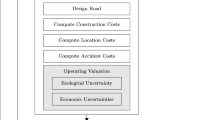Residential lakeshore development is causing increasing pressure on the lacustrine environment. Traditional landscaping patterns produce lakes ringed with lawns at the expense of the naturally occurring shoreline habitat. In this work, we present a mathematical model to select path locations to minimize impacts on the lakeshore environment, while providing convenient access to the landowners.





Similar content being viewed by others
References
D. Lemberg, R. Fraser and J. Marsch, Perceptions of lakeshore living: implications for planning sustainable lakeshores, Mich. Riparian 37(4) (2002) 8–10, 38(1) (2003) 8–11.
Q. Gillard, The effect of environmental amenities on house values: the example of a view lot, Prof. Geogr. 33(2) (1981) 216–220.
B.H. Smith, The effect of ocean and lake coast amenities on cities, J. Land Econ. 33 (1993) 115–123.
F. Spalatro and B. Provencher, An analysis of minimum frontage zoning to preserve lakefront amenities, Land Econ. 77(4) (2001) 469–481.
J.I. Nassauer, S.E. Kosek and R.C. Corry, Meeting public expectations with ecological innovation in riparian landscapes, J. Am. Water Resour. Assoc. 37(6) (2001) 1439–1443.
B.S. Jorgensen and R.C. Stedman, Sense of place as an attitude: lakeshore owners attitudes toward their properties, J. Environ. Psychol. 21 (2001) 233–248.
T.V. Stein and D.H. Anderson, Combining benefits-based management with ecosystem management for landscape planning: leech Lake watershed, Minnesota, Landsc. Urban Plan. 60 (2002) 151–161.
N.H. Lansford and L.L. Jones, Marginal price of lake recreation and aesthetics: an hedonic approach, J. Agric. Appl. Econ. 27(1) (1995) 212–223.
C. Siderelis and G. Perrygo, Recreation benefits of neighboring sites: an application to riparian rights, J. Leis. Res. 28(1) (1996) 18–26.
T. Reed-Anderson, E.M. Bennett, B.S. Jorgensen, G. Lauster, D.B. Lewis, D. Nowacek, J.L. Riera, B.L. Sanderson and R. Stedman, Distribution of recreational boating across lakes: do landscape variables affect recreational use, Freshw. Biol. 43 (2000) 439–448.
P. Cheshire and S. Sheppard, On the price of land and the value of amenities, Economica 62 (1995) 247–267.
J. Geoghegan, The value of open spaces in residential land use, Land Use Policy 19 (2002) 91–98.
C.G. Leggett and N.E. Bockstael, Evidence of the effects of water quality on residential land prices, J. Environ. Econ. Manage. 39 (2000) 121–144.
W. Kriesel, A. Randall and F. Lichtkopper, Estimating the benefits of shore erosion protection on Ohio's Lake Erie housing market, Water Resour. Res. 29(4) (1993) 795–801.
A.S.L. Rodrigues and K.J. Gaston, Optimization in reserve selection procedures – why not, Biol. Conserv. 107 (2002) 123–129.
C.S. ReVelle, J.C. Williams and J.J. Boland, Counterpart models in facility location science and reserve selection science, Environ. Model. Assess. 7 (2002) 71–80.
K.D. Cocks and I.A. Baird, Using mathematical programming to address the multiple reserve selection problem: an example from the Eyre Peninsula, South Australia, Biol. Conserv. 49 (1989) 113–130.
R.L. Church, D.M. Stoms and F.W. Davis, Reserve selection as a maximal covering problem, Biol. Conserv. 76 (1996) 105–112.
R.L. Pressy, H.P. Possingham and J.R. Day, Effectiveness of alternative algorithms for identifying indicative minimum requirements for conservation reserves, Biol. Conserv. 80 (1997) 207–219.
K.E. Rosing, C.S. ReVelle and J.C. Williams, Maximizing special representation under limited resources: a new and efficient hueristic, Environ. Model. Assess. 7 (2002) 91–98.
R. Briers, Incorporating connectivity into reserve selection procedures, Biol. Conserv. 103 (2002) 77–83.
M.A. Clemins, C.S. ReVelle and J.C. Williams, Reserve design for species preservation, Eur. J. Oper. Res. 112(2) (1999) 273–283.
M.D. McDonell, H.P. Possingham, I.R. Ball and E.A. Cousins, Mathematical methods for spatially cohesive reserve design, Environ. Model. Assess. 7 (2002) 107–114.
R.G. Haight, C.S. ReVelle and S.A. Snyder, An integer optimization approach to a probabilistic reserve site selection problem, Oper. Res. 48(5) (2000) 697–708.
S. Polasky, J.D. Camm, A.R. Solow, B. Csuti, D. White and R. Ding, Choosing reserve networks with incomplete species information, Biol. Conserv. 94 (2000) 1–10.
J.C. Williams and C.S. RaVelle, A 0–1 programming approach to delineating protected reserves, Environ. Plann., B 23(5) (1996) 607–624.
J.C. Williams and C.S. RaVelle, Reserve assemblage of critical areas: A zero–one programming approach, Eur. J. Oper. Res. 104 (1998) 497–509.
D.J. Nalle, J.L. Arthur, C.A. Montgomery and J. Sessions, Economic and spatial impacts of an existing reserve network on future augmentation, Environ. Model. Assess. 7 (2002) 99–105.
S.A. Malcolm and C.S. ReVelle, Rebuilding migratory flyways using directed conditional covering, Environ. Model. Assess. 7 (2002) 129–138.
H. Önal and R.A. Briers, Incorporating spatial criteria in optimum reserve network selection, Proc. R. Soc. Lond., B Biol. Sci. 269 (2002) 2437–2441.
J. Cohon, Multiobjective Programming and Planning (Academic, New York, 1978).
S. Hakimi, Optimum locations of switching centers and the absolute centers and medians of a graph, Oper. Res. 12 (1964) 462–475.
A.T. Murray and R.L. Church, Using proximity restrictions for locating undesirable facilities, Stud. Locat. Anal. 12(1) (1999) 81–99.
E. Dijkstra, A note on two problems in connexion with graphs, Numer. Math. 1 (1959) 269–271.
Acknowledgements
This research was funded by U.S. EPA Science to Achieve Results (STAR) Program Grant #R-82758401 with additional funding from a Kalamazoo Foundation Community Watershed Grant. I would also like to thank the anonymous reviews for their illuminating and constructive comments.
Author information
Authors and Affiliations
Corresponding author
Rights and permissions
About this article
Cite this article
Lemberg, D.S., Fraser, R. The residential lakeshore access allocation problem: Minimizing barrier effects on shoreline habitat buffers. Environ Model Assess 10, 265–276 (2005). https://doi.org/10.1007/s10666-005-9000-z
Published:
Issue Date:
DOI: https://doi.org/10.1007/s10666-005-9000-z




